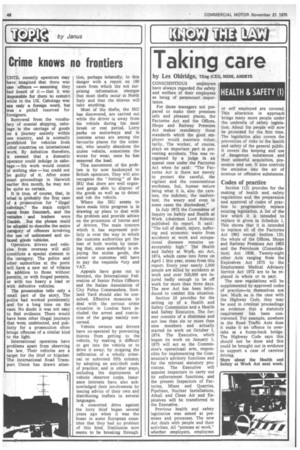Taking care
Page 52

If you've noticed an error in this article please click here to report it so we can fix it.
by Les Oldridge, TEng (CEO, MIMI, AMIRTE CONSCIENTIOUS emPloyers have always regarded the safety and welfare of their employees as being of paramount importance.
For those managers not prepared to make their premises safe and pleasant places, the Factories Act and the Offices, Shops and Railway Premises Act makes mandatory those standards which the good employer would maintain voluntarily., The worker, of course, plays an important part M preventing accidents. This was recognised by a judge in an appeal case under the Factories Act when he said: -The Factories Act is there not merely to protect the careful, the vigilant and the conscientious workman, but, human nature being what it is, also the careless, the indolent, the inadvertent, the weary and even in some cases the disobedient."
In July 1972 the Committee of Inquiry on Safety and Health at Work (chairman Lord Robens) published its report. It said: "The toll of death, injury, suffering and economic waste from accidents at work and occupational diseases remains unacceptably high." The Health and Safety at Work, etc Act, 1974, which came into force on April 1 this year, sterns from this report. Every year nearly 1,000 people are killed by accidents at work and over 500,000 are injured badly enough to be off work for more than three days. The new Act has been introduced to combat this situation.
Section 10 provides for the setting up of a Health and Safety Commission and a Health and Safety Executive. The former consists of a chairman and not less •than six or more than nine members and actually started its work on October 1, 1974. The Executive, which began its work on January 1, 1975 will act as the Commission's operational arm, responsible for implementing the Commission's advisory functions and for the relevant statutory provisions. The Executive will appoint inspectors to carry out its enforcement functions, and the present Inspectors of Factories, Mines and Quarries, Pipelines, Nuclear Installations, Alkali and Clean Air and Explosives will be transferred to the Executive.
Previous health and safety legislation was aimed at premises and processes. The new Act deals with people and their activities. All "persons at work," whether employers, employees or self employed are covered. This alteration in approach brings many more people under the umbrella of safety legislation. About 5m people will now be protected for the first time. The legislation also covers the prevention of risks to the health and safety of the general public. It covers the keeping and use of dangerous substances and their unlawful acquisition, possession and use. It also controls the emission into the air of noxious or offensive substances.
Codes of practice
Section 1(2) provides for the making of health and safety regulations and the preparation and approval of codes of practice to progressively replace existing legislation. A list of the law which it is intended to replace is given in Schedule 1. This shows that it is intended to replace all of the Factories Act 1961 except Section 135; the whole of the Offices, Shops and Railway Premises Act 1963 and the Petroleum (Consolidation) Act 1928. Twenty-eight other Acts ranging from the Explosives Act 1875 to the Employment Medical Advisory Service Act 1972 are 'to be replaced in whole or in part.
The new regulations will be supplemented by approved codes of practice—in themselves not law. Much as is the case with the Highway Code, they may be used in criminal proceedings as evidence •that a statutory requirement has been contravened. For example, nowhere in the Road Traffic Acts does it make it an offence to overtake at a hump-back bridge. The Highway Code says this should not be done and this could be brought out in evidence to support a case of careless driving.
More about the Health and Safety at Work Act next week.








































































































